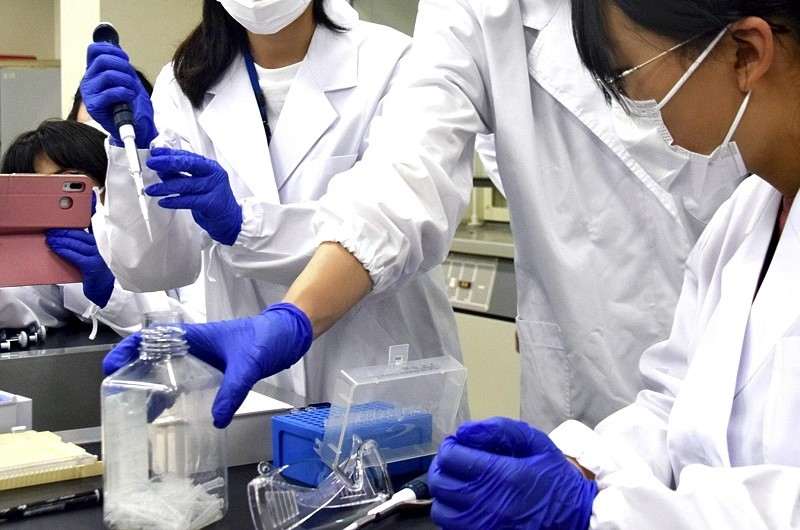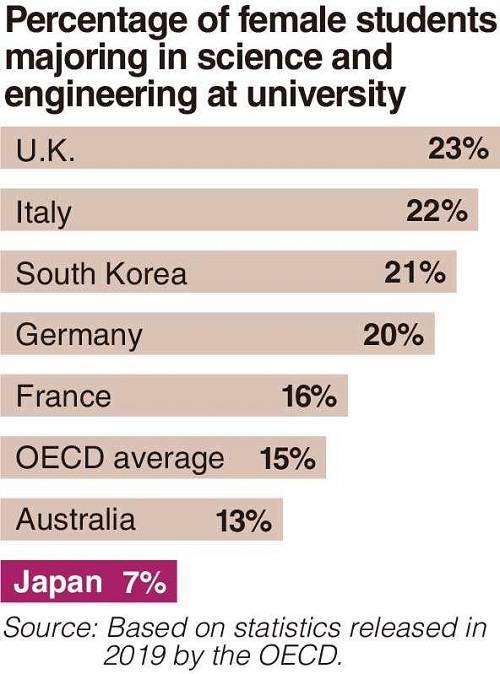With only 7% of women majoring in science and engineering, Japan gets serious about supporting their careers

Junior high school students, assisted by university students, learn a PCR-related technique at the University of Hyogo’s Harima Campus for Science in Kamigori, Hyogo Prefecture on Aug. 19.
7:10 JST, September 20, 2022
The government has set about supporting female students who wish to pursue science and engineering at university.
It believes that having women enter these fields is indispensable to solving the labor shortage in such growth fields as digital technology. The focus will be on whether the government can encourage reforms at universities that accept these students.
Starting in junior high
At the University of Hyogo’s Harima Campus for Science, located in Kamigori, Hyogo Prefecture, junior high school girls were trying to pipette a minute amount of liquid with serious looks on their faces on Aug. 19 during their summer break. They were conducting an experiment to create a reaction solution for PCR, which is also used to test for the novel coronavirus.
A second-year junior high school student, 13, said with satisfaction, “It was fun to learn how various things work together.” The event was organized by the Tatsuno municipal government in Hyogo Prefecture as part of the “Summer science challenge” program, which is promoted by the Cabinet Office and other organizations to encourage girls to pursue the sciences. On the same day, 33 junior high school students from the city took a bus tour of local universities and research institutes.
In recent years, the need for engineering personnel has been growing in such fields as IT and decarbonization. Half of the 92 organizations participating in this year’s “Summer science challenge” were private companies such as Fuji Film Corp. and Asahi Kasei Corp.

The Economy, Trade and Industry Ministry estimates that there will be a shortage of up to 790,000 workers in IT-related fields by 2030. According to a labor force survey conducted by the Internal Affairs and Communications Ministry in 2021, out of the 2.56 million workforce in the information and communications industries, 740,000 are women, representing less than 30%. To bridge the gender gap, and solve the labor shortage, there is an urgent need to foster women in engineering.
According to 2019 statistics released by the Organization for Economic Cooperation and Development (OECD), the percentage of women who majored in science and engineering fields at Japanese universities was 7%, the lowest among member countries.
Noriko Osumi, vice president of Tohoku University and an expert on women’s education, said that there are few role models for women to guide their thinking and decisions on career choices, adding that “it is difficult for girls to decide without hesitation to major in science at university.”
A 42-year-old high school math teacher in Tokyo said, “Some parents have told me, ‘If they go on to graduate school in science, they may delay getting married and they will have to pay high tuition fees.’”
On Sept. 2, the government formulated a schedule to raise the percentage of all university students majoring in the sciences from the current 35% to 50%. At a press conference, Education, Culture, Sports, Science and Technology Minister Keiko Nagaoka said, “We must overturn the gender bias and create a society in which men and women can decide on their university majors on an equal footing,” implying that she will particularly focus on supporting women to major in science.
Faculty conversions
In the industrial world, there are also high expectations for “gendered innovation,” in which women bring fresh ideas to research and development, which is traditionally male-dominated. Last year, Shintaro Yamada, the founder of Mercari Inc., operator of a flea market app, established his own foundation and started a scholarship program for female students majoring in science and engineering. He plans to invest ¥3 billion of his own money to expand the scholarship to about 1,000 students in the future. The government’s timetable includes the launch in fiscal 2024 of a privately funded program to support female students studying science engineering.
Reforms on the part of universities are also urgently needed. Nara Women’s University became the first women’s university to open a faculty of engineering this April, and Ochanomizu University plans to establish what is tentatively called the Faculty of Transdisciplinary Engineering in fiscal 2024. The education ministry will establish a fund in fiscal 2023 to support universities aiming to create science and engineering faculties.
Shibaura Institute of Technology, Nagoya University and other universities have even introduced a system to set a “female students quota” for entrance examinations in science and engineering fields. However, it is difficult to introduce such a system on a large scale due to the desire for gender equality.
Private universities, which account for 80% of all universities, mainly have liberal arts departments. With competition over students intensifying due to the declining birthrate, “just requiring students to take a mathematics test in the entrance exam will reduce the number of applicants. It is hard to see any prospect of attracting more students,” said a senior official at a private university.
"Society" POPULAR ARTICLE
-

M4.9 Earthquake Hits Tokyo, Neighboring Prefectures
-

Israeli Tourists Refused Accommodation at Hotel in Japan’s Nagano Pref., Prompting Protest by Israeli Embassy and Probe by Prefecture
-

M7.5 Earthquake Hits Northern Japan; Tsunami Waves Observed in Hokkaido, Aomori and Iwate Prefectures
-

Tsukiji Market Urges Tourists to Avoid Visiting in Year-End
-

M5.7 Earthquake Hits Japan’s Kumamoto Pref., Measuring Upper 5 Intensity, No Tsunami Expected
JN ACCESS RANKING
-

Tokyo Economic Security Forum to Hold Inaugural Meeting Amid Tense Global Environment
-

Keidanren Chairman Yoshinobu Tsutsui Visits Kashiwazaki-Kariwa Nuclear Power Plant; Inspects New Emergency Safety System
-

Imports of Rare Earths from China Facing Delays, May Be Caused by Deterioration of Japan-China Relations
-

University of Tokyo Professor Discusses Japanese Economic Security in Interview Ahead of Forum
-

Japan Pulls out of Vietnam Nuclear Project, Complicating Hanoi’s Power Plans






















